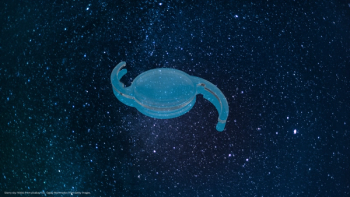
Endophthalmitis associated with corneal suture infections
In a recent study, Dr Henry and colleagues looked at a series of patients with delayed-onset endophthalmitis associated with corneal suture infections, finding that removal of loose or elevated sutures should be considered when the wound is stable to help prevent serious complications.
The study
All six patients were using topical prednisolone acetate 1% at the time of diagnosis of a corneal suture infection. The mean length of time from most recent ocular surgery to the development of endophthalmitis was 565 days (range: 58–1324). All six eyes were pseudophakic and three of six eyes had an intact posterior capsule.
Mechanisms that were temporally related to the development of endophthalmitis included the removal of a loose or exposed suture (two patients), a broken running suture (one patient), and manipulation of a loose running suture (one patient). In each of these four eyes, the corneal infiltrate was present at the time of suture removal or manipulation. One of these patients was not initially administered topical antibiotics despite the presence of a corneal infiltrate and active manipulation of a suture. After presentation with a corneal infiltrate, topical prednisolone acetate 1% was continued at the same frequency in four patients, decreased in one patient, and stopped altogether in a final patient. The mean length of time from suture manipulation to diagnosis of endophthalmitis was 18 days (range: 4–57). A corneal perforation developed in three eyes, of which two eyes had undergone recent suture manipulation.
Previous investigators have recommended that penetrating keratoplasty sutures preferably be removed by 12–18 months after the operation or at discharge of patient care.1,6,7 In our recently published study, there were three eyes that developed endophthalmitis from a corneal suture infection where the suture had been retained for over 2 years following the original transplant.
In regards to management, one eye was treated with primary enucleation. All of the remaining five eyes were treated with intravitreal and topical antibiotics. Two eyes underwent repeat penetrating keratoplasty with anterior chamber washout and intraocular antibiotics, one eye underwent pars plana vitrectomy with intraocular antibiotics, and one eye underwent both a pars plana vitrectomy and penetrating keratoplasty. However, despite prompt recognition of endophthalmitis and appropriate management, visual outcomes in these patients remained poor with best-corrected visual acuity ranging from 20/150 to no light perception. Two eyes ultimately required enucleation.
Conclusions
Corneal suture infections are not uncommon, but fortunately they rarely progress to endophthalmitis. Our recent study found that Streptococcus isolates were identified in nearly all patients developing delayed-onset endophthalmitis from a corneal suture infection. This study also identified topical steroid use and suture manipulation as associated factors for developing endophthalmitis. Visual outcomes were poor despite prompt diagnosis of endophthalmitis and appropriate antibiotic therapy.
Dr Harry W. Flynn Jr, senior investigator for the study, summarized as follows, "These challenging cases often respond slowly to topical and intravitreal therapy. While we do not believe that all corneal sutures need be removed, removal of loose or elevated sutures should be considered when the wound is stable to help prevent this serious complication. Suture removal is particularly important with exposed knots or suture ends that collect mucous and surface bacteria."
References
1. C.R. Henry et al., J. Ophthalmic Inflamm. Infect., 2013:3:51.
2. C.R. Henry et al., Ophthalmology, 2012;119:2443–2449.
3. C.G. Christo et al., Cornea, 2001;20:816–819.
4. A.B. Leahey et al., Cornea, 1993;12:489–492.
5. C. Siganos, A. Solomon and J. Frucht-Pery, Ophthalmology, 1996;104:513–516
6. H. Jackson and R. Bosanquet, Br. J. Ophthalmol., 1991;75:663–664.
7. L. Mowatt and L. Butler, J. Cataract Refract. Surg., 2004:30:1152.
Newsletter
Get the essential updates shaping the future of pharma manufacturing and compliance—subscribe today to Pharmaceutical Technology and never miss a breakthrough.












































